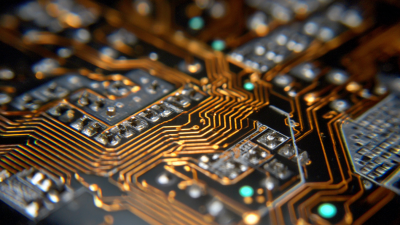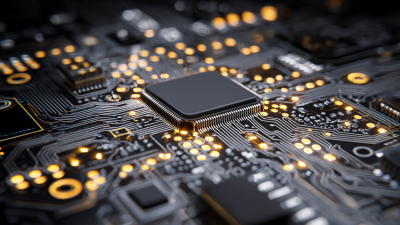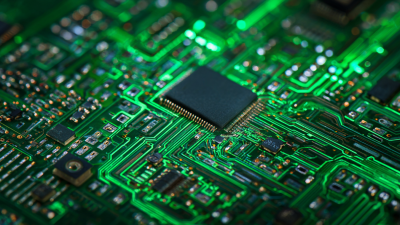Solder mask plays a crucial role in enhancing the durability and performance of printed circuit boards (PCBs), which are the backbone of modern electronics. With the global PCB market projected to reach $80 billion by 2026, according to a report by ResearchAndMarkets, the importance of effective solder mask application cannot be overstated. This protective layer not only safeguards against oxidation and short circuits but also helps in preventing solder bridging and ensures cleaner assembly processes.

Furthermore, studies indicate that PCBs with robust solder mask finish can lead to a 30% increase in longevity and reliability, making it an essential component in high-performance electronic devices. Understanding the properties and applications of solder mask is vital for those engaged in PCB design and manufacturing, as it significantly influences both the manufacturability and operational efficiency of electronic products.
In the realm of PCB design and manufacturing, solder mask plays a pivotal role in enhancing the durability and performance of printed circuit boards. This specialized coating, typically made from epoxy or polyester, creates a barrier that protects the copper traces from environmental factors such as moisture, dust, and chemicals. By insulating the conductive paths, solder masks also prevent solder bridging during assembly, ensuring cleaner and more reliable connections.
Moreover, the importance of solder mask extends beyond mere protection. It contributes to the overall aesthetics and functionality of a PCB. Different colors of solder masks can be employed for easy identification of different circuit components, assisting in the maintenance and troubleshooting processes. Additionally, a well-applied solder mask can improve the thermal management of the PCB by reducing the chances of overheating, thus directly impacting the performance of the electronic devices. In summary, solder mask is integral not only for safeguarding PCBs from external threats but also for optimizing their operational efficiency and visual appeal.
 Solder mask plays a pivotal role in enhancing the performance and durability of printed circuit boards (PCBs). This thin layer of polymer ensures that only designated areas of a PCB are soldered, thereby preventing unintended connections that can lead to short circuits. According to IPC-2221A standards, the presence of an effective solder mask can improve the board’s resistance to environmental factors, reducing the impact of moisture and contaminants that can corrode metal traces. Reports show that PCBs without solder mask have a failure rate that can increase by up to 60% in high-humidity conditions, highlighting the critical nature of this protective layer.
Solder mask plays a pivotal role in enhancing the performance and durability of printed circuit boards (PCBs). This thin layer of polymer ensures that only designated areas of a PCB are soldered, thereby preventing unintended connections that can lead to short circuits. According to IPC-2221A standards, the presence of an effective solder mask can improve the board’s resistance to environmental factors, reducing the impact of moisture and contaminants that can corrode metal traces. Reports show that PCBs without solder mask have a failure rate that can increase by up to 60% in high-humidity conditions, highlighting the critical nature of this protective layer.
In addition to its protective qualities, solder mask contributes to the overall performance of PCBs through enhanced electrical insulation. The dielectric strength of common solder masks can reach up to 500 volts per mil, which significantly mitigates the risk of crosstalk between closely spaced traces on a circuit board. According to a study by the IPC, boards utilizing advanced epoxy-based solder masks can achieve upwards of 30% better electrical performance and thermal stability compared to those with inferior materials. As industries move towards smaller, more complex designs, the importance of solder mask cannot be overstated; it is essential for ensuring not only the reliability but also the efficiency of electronic devices.
When selecting a solder mask for printed circuit boards (PCBs), understanding the materials and types available is crucial to ensuring both durability and performance. The choice of solder mask can significantly impact the longevity of the PCB, with industry studies indicating that quality solder masks can enhance the protection against moisture and contaminants, reducing failure rates by up to 25%. Common materials include epoxy, polyimide, and liquid photoimageable (LPI) solder masks, each offering unique benefits in terms of thermal resistance and chemical stability.
Tips: Always consider the specific application of your PCB when choosing a solder mask. For high-temperature environments, opt for polyimide masks, which exhibit superior thermal and chemical properties. Alternatively, for standard applications, a well-formulated epoxy solder mask may provide adequate protection and cost-effectiveness.
Another critical factor in selecting the right solder mask is thickness. Research shows that variations in solder mask thickness can influence the board's solderability and overall performance. A thickness of 3 to 5 mils is commonly recommended, but adjusting this based on the complexity of the PCB design and the expected operating conditions can yield better results. Adjust your choice according to the planned soldering methods, as thicker masks may hinder fine-pitch soldering techniques.

Solder mask is a crucial component in the assembly of printed circuit boards (PCBs), serving as a protective layer that enhances durability and electrical performance. However, the application of solder mask is not without its challenges. Common difficulties include incomplete coverage, adhesion issues, and the presence of particulate contamination, which can compromise the integrity of the PCB. According to a recent industry report, improper solder mask application can lead to defects that escalate repair costs by up to 30%, highlighting the importance of addressing these challenges proactively.
Solutions for effective solder mask application are increasingly turning to advanced technologies. For instance, the adoption of plasma treatment methods has emerged as a reliable solution to enhance adhesion and remove contaminants. Recent breakthroughs in plasma technology have shown promise in providing uniform coverage while minimizing the risk of defects. Reports indicate that utilizing plasma processes can improve the overall yield of PCBs by as much as 20%, demonstrating significant improvements in both performance and cost efficiency for manufacturers. As the industry continues to evolve, staying informed about these advancements is essential for optimizing solder mask application and ensuring robust PCB performance.
Maintaining solder mask integrity throughout the lifespan of a printed circuit board (PCB) is critical for ensuring the device's durability and performance. One of the best practices is to avoid exposing the PCB to harsh environmental conditions such as humidity and extreme temperatures, which can degrade the solder mask over time. Implementing protective packaging during storage and transport can help safeguard the solder mask, preventing physical damage and exposure to moisture.
Another essential practice involves routine inspection and maintenance of the PCB. Regular checks can identify early signs of solder mask wear, such as discoloration or peeling. If these issues are spotted early, they can be promptly addressed, minimizing the risk of more significant damage that could impact performance. Additionally, ensuring that the assembly process is clean and free from contaminants is vital, as impurities can compromise the adhesion and effectiveness of the solder mask. By prioritizing these best practices, manufacturers and users can significantly extend the lifespan of the PCB while maintaining its optimal performance.






„Thanks to the LUVIR technology, the solder resist process could be switched directly from the previously used mask exposure to direct exposure. As an outstanding digital solution on the market, this technology has been able to demonstrate fast process times and superior quality on our certified conventional ink in production. This allowed us to fully digitize the solder mask process at low cost – without process or ink adjustments. An excellent benefit to our production in Rot am See.“
Ralf Göhringer (Head of Production WE Rot am See)
I would definitely recommend the Limata machine and team for a future company purchase
Michael Greenaway
Compunetics Inc.
“The Limata ldi has been amazing!! Best thing we did was buy this machine”
Richard Brady
GM
Circuitlabs
“Since 2019, we have been running the Limata X1000 LDI system (including LUVIR for solder mask imaging) in daily production as an addition to our current process with film. The machine was capable of properly exposing Taiyo PSR-4000 BN (DI) solder mask types on normal to high-copper boards using a new and unique direct imaging process. The machine operating interface is very user friendly which allowed for a quick technical training curve. The pre-registration processing reduced several seconds of production time at every print. Limata support and service staff is incomparable. They supported our team every step of the way at basically any time of the day or night, with literally, an immediate response time, customizing the software interface to best fit our Operations and needs.
We have exposed more than 8,000 prints since end of October, on various solder mask colors and some resist film panels. Limata, has proven to be very capable and innovative. They are a strong contender in the industry.
We have very much enjoyed this project, and working with the team!
Thank you Limata for the continued support and being a part of our growth.”
Bill Sezate
Vice President, GM
Summit Interconnect
As a replacement to our current contact exposure process with film, the LIMATA X2000 system including LUVIR-Technology was capable of properly exposing non-LDI solder mask types using a direct imaging process. The machine offers cutting edge software with a very intuitive operating interface which allowed for quick technician training curve. The dual drawer system combined with pre-registration processing reduced several seconds of production time at every machine cycle. Limata support and service staff is world class. They added software patches to keep production running at shortest possible response times, customized the software interface to best fit our in-house Operations system, and even wrote a step-by-step machine processing manual. As a result of the project, we have exposed more than 16,000 times on various product types and solder mask brands/colors. Limata, in a very short timeframe as a company, has definitely shown they are truly innovative and will be challenging the industry of direct imaging for the top spot.
Kevin Beattie
Process Engineer
TTM Technologies
Forest Grove Division